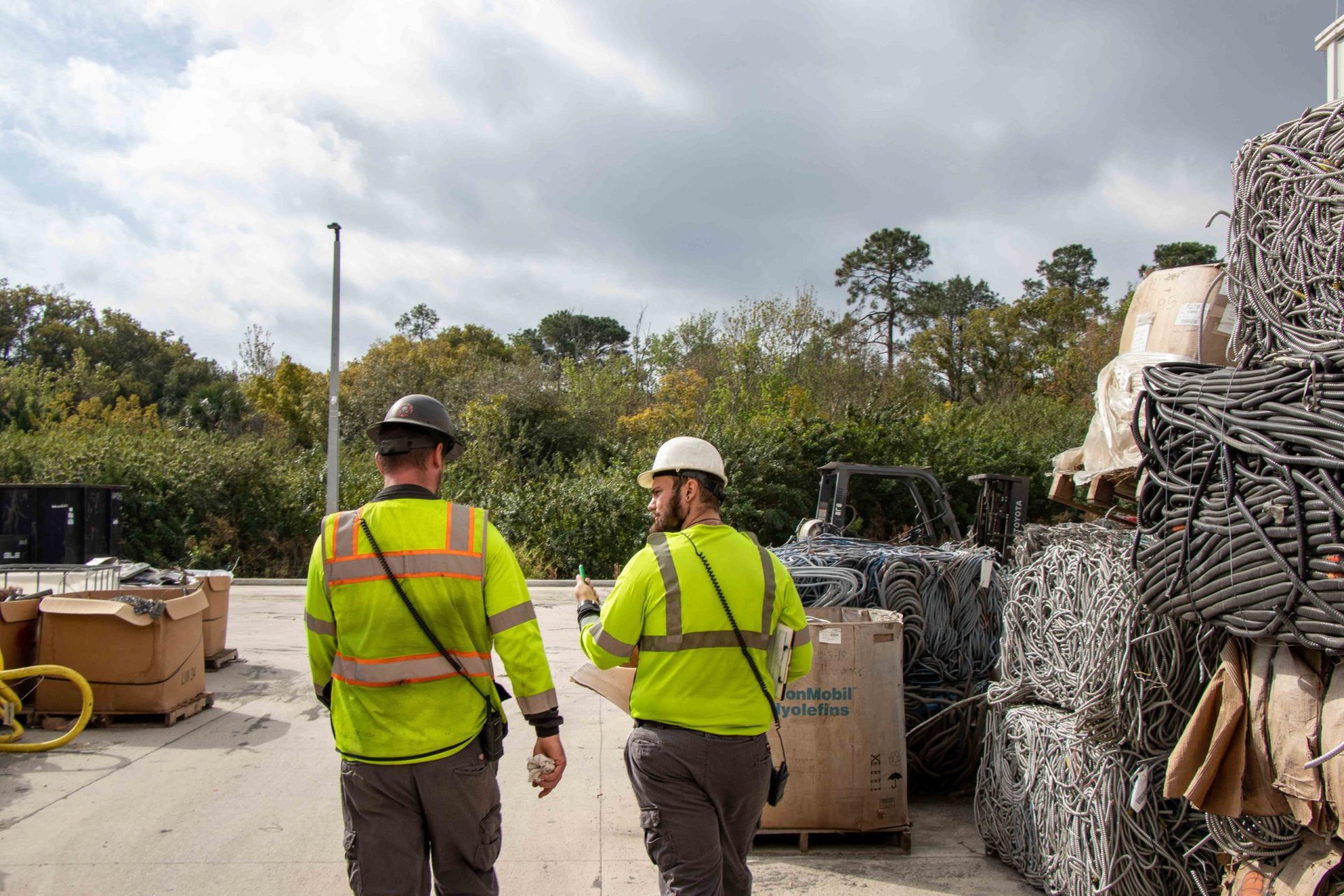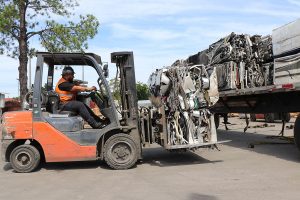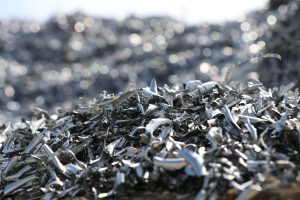
Metal recycling scrap yards can seem intimidating when you don’t know much about them. A lack of information has led to misconceptions about scrap yards being spread.
This leads to people missing out on this amazing opportunity to protect the planet and save money.
So, to make it a little less overwhelming and scary, we put together a comprehensive guide to metal recycling scrap yards.
In this article, you will learn:
- How metal recycling scrap yards work
- Steps for recycling your scrap metal
- Misconceptions about metal recycling scrap yards
- State laws you should know before going to a metal recycling scrap yard in Michigan or Florida
- Tips for ensuring everyone’s safety when visiting metal recycling scrap yards
How Do Metal Recycling Scrap Yards Work?

Recycling scrap yards buy, process, and then re-integrate scrap metal to efficiently utilize natural resources and help conserve energy. They work with both individuals and businesses to help clean out their space and provide an additional stream of revenue.
They leverage their market knowledge and close relationships with domestic mills & global end-users to offer competitive prices.
Steps For Going To A Recycling Scrap Yard
While the act of recycling metal is a more intensive process that requires training, your part is pretty easy.
1. Collect Scrap
Start by looking around your home or business for scrap metal lying around. You can create a recycling program for your business to make the collection even easier.
Make sure to get designated sturdy bins to keep in your garage or business for collecting and holding scrap.
2. Sort Scrap
Sort metals by ferrous and non-ferrous, type, and purity levels. This is because each has a different value and when they are mixed together it can bring down the overall value.
You can identify ferrous vs non-ferrous with a magnet because ferrous metals are magnetic. The type of metal can be determined by color, flexibility, and even sound.
3. Find A Trusted Recycling Scrap Yard
Look for a certified company that has reviews from past customers and see what they are saying. Do the employees seem helpful and knowledgeable? Are people satisfied with their experience?
4. Weigh In
Drive to the designated spot and get your metals weighed by state-certified scales. Employees and signage at the facility will direct you to the right spot.
The weight will help to determine the value of your load.
5. Drop-Off Scrap
Drop off the load with the facility in the designated spot and get a detailed breakdown. For smaller vehicles, there is often a drive-thru you can go through, so you do not have to walk far with your load.
6. Get Paid
Once you’ve dropped off your metal and gotten the breakdown you can go to the pay station. Depending on the state you will be required to show your ID and records.
Some facilities allow you to choose cash or check payment depending on the load. Additionally, some allow you to choose if you want payment on the same day or on a monthly basis and may even have on-site ATMs.
Recycling facilities follow local rules and regulations for metals, and payment and regulated materials must have the proper paperwork.
Seems simple right? Sadly many misconceptions about recycling centers deter people from recycling. So, let us debunk a few.
Misconceptions About Recycling Scrap Yards

When people picture recycling scrap yards, they may picture a lot of things. Big dangerous equipment. Long-tedious processes. Dirty metal everywhere.
But, in reality, recycling scrap yards are nothing like that! Here are a few truths about common misconceptions.
You Can Always Make Lots of Profit With No Effort
While it is sometimes easy to make money with scrap recycling, some people think recycling is the perfect get-rich-quick job and that they can bring in a few soda cans and make hundreds.
In order to see real value you need to put in a little more work. First, you will want to sort your scraps before bringing them to the scrap yard to maximize the value you receive in return. You’ll also want to wait until you have a decent amount of scrap piled up.
Lastly, you will want to call ahead and see what the market value is. If you can’t get to the scrap yard while the prices are high some scrap yards let you lock in the best price with a hedging program.
They’re Dangerous
A common misconception about scrap yards is that they are unsafe. In reality, metal recycling facilities are very safe and follow stringent guidelines.
Recycling facilities are designed to keep employees and customers safe. All of the big machines and equipment are only used by trained professionals and are far away from customer drop-off zones.
Not Environmentally Friendly
Recycling reduces the need for mining raw materials which can help protect our natural resources. The act of mining can release toxic minerals and impact the environment creating sinkholes or destroying wildlife habitats.
Not only that, but recycling metal also conserves energy. The Environmental Protection Agency found that recycling aluminum can save 95% of energy compared to using raw materials. Recycling steel and tin can save about 60-74% of energy.
Too Complicated
Many people don’t understand the process of recycling metal, so they build it up in their heads. While there are a lot of steps that go into it, most of the process is done by a trained facility.
All you have to do is drive to the facility, weigh in, and cash out. Plus, some facilities offer transportation services to businesses that have a lot of scraps, including providing roll-off boxes.
Time-Consuming
As we mentioned earlier, most of the work is done by the recycling facility, so you don’t have to worry about the process taking a while. Recycling scrap yards that have been around for a while have been able to fine-tune the process to make it as pain-free and fast as possible for their customers.
State Laws To Understand Before Going To A Scrap Yard
Not understanding how everything works can be overwhelming. Each state requires different protocols when selling metals to scrap yards to ensure everyone’s safety.
To make the idea a little less scary, we compiled some things to be aware of before going to a Florida or Michigan metal recycling scrap yard.
Florida Scrap Yard Laws
- Driver’s License – scrap yards keep a copy on file
- Signature – must sign a statement of ownership
- Fingerprint – all sellers are required to be fingerprinted
- Records – records of purchases made
Michigan Scrap Yard Laws
- Driver’s License – present ID for them to keep a copy on file
- License plate – scrap yards keep a record of plate number
- Signature – must sign that you are allowed to sell metals
- Fingerprint – all sellers are required to be fingerprinted
- Photo – While there, they will take a picture of scrap seller
- Tag & hold – 7-day tag and hold policy applied for most non-ferrous metals
Now that you know the processes and rules for recycling your scrap metal, here are a few tips to ensure utmost safety while visiting a metal recycling scrap yard.
How To Stay Safe When Visiting

While certified recycling facilities follow rules and regulations, accidents can happen when customers aren’t careful. Here are a few things to keep in mind to stay safe when visiting a recycling facility.
Don’t Climb On Scrap
We understand it can be tempting to climb the pile of scrap for fun or because you found something you’d like. But, the metals can shift and you can get scraped by unclean metals or seriously injured.
Plus there are often machinery dropping or collecting metals and the operator may not see you.
Dress Appropriately
If you are going to be unloading scraps, it is important to dress appropriately for your safety. This means close-toed shoes or work boots and clothes that won’t catch on things.
You will also want to cover up as much skin as possible to avoid getting cut by the metals you are handling. While not required, you can also wear goggles and gloves for extra protection and reflective, bright clothes for more visibility.
Drive Slowly And Patiently
Recycling facilities have a lot of foot and vehicle traffic, so it is important to drive slowly and carefully when dropping off scraps.
You may occasionally have to wait for another customer to finish unloading before you can. Please be patient, and if you have to exit the line be cautious of people unloading. Do not try to drive the wrong way or through other parts of the yard because it can be blocked off for safety reasons.
Watch Where You’re Going
While most of the heavy machinery is tucked back away from where you will be, it is still important to stay vigilant. People are moving around with sharp or heavy objects, so it’s best to stay aware of your surroundings.
Besides watching out for foot and vehicle traffic, you also want to keep an eye out for mud, ice, or holes caused by elements. There are also parts of the facility restricted to employees only for your safety, so be sure not to cross without an escort.
Stay In Your Car Or At The Cashier Unless Told Otherwise
Recycling facilities are very safe because they closely follow guidelines that are designed to keep employees and customers safe. One rule is keeping customers in designated safe spots away from machinery. This helps to keep everything efficient and reduces the risk of any incidents occurring.
There are often designated spots that you can pull your car up to and employees to guide you. Only the people actively unloading materials should be outside of the vehicle. That way no one is wandering off or getting in other customers’ way.
Recycle Your Scrap Metal With GLE Scrap
Now, you can see why recycling scrap yards aren’t as scary and complicated as many think. In fact, with the right partner, it can be seamless.
Ready to get started? Recycle with GLE Scrap today! We are a certified metal recycling company with recycling scrap yards across Florida and Michigan.
Our team is always here to answer all of your questions and make the recycling process as easy and stress-free as possible.
Partner with GLE Scrap and give us a call at 855-SCRAP-88 to request a FREE quote.



